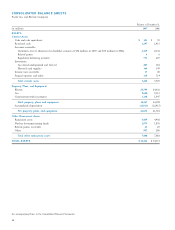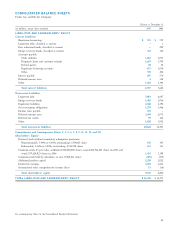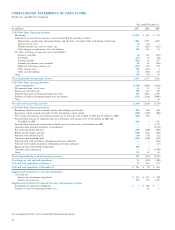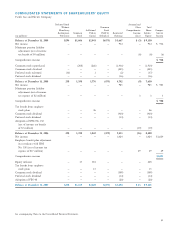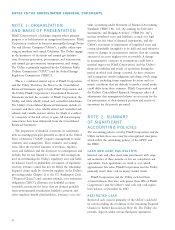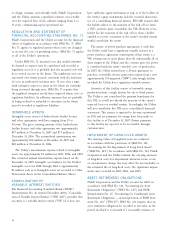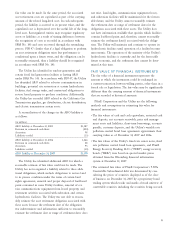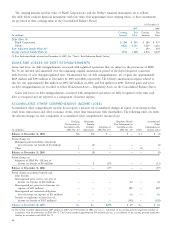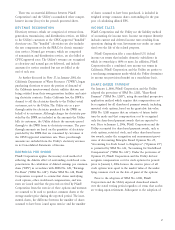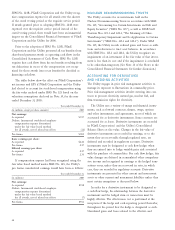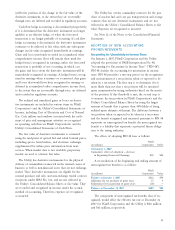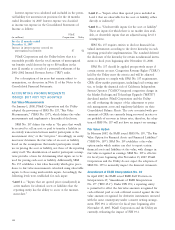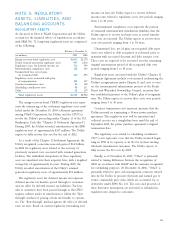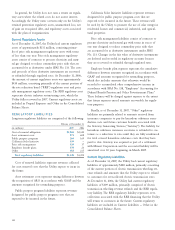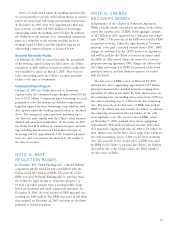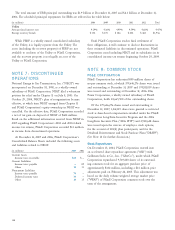PG&E 2007 Annual Report Download - page 100
Download and view the complete annual report
Please find page 100 of the 2007 PG&E annual report below. You can navigate through the pages in the report by either clicking on the pages listed below, or by using the keyword search tool below to find specific information within the annual report.
98
SFAS No. 123R, PG&E Corporation and the Utility recog-
nize compensation expense for all awards over the shorter
of the stated vesting period or the requisite service period.
If awards granted prior to adopting SFAS No. 123R were
expensed over the requisite service period instead of the
stated vesting period, there would have been an immaterial
impact on the Consolidated Financial Statements of PG&E
Corporation and the Utility for 2006.
Prior to the adoption of SFAS No. 123R, PG&E
Corporation and the Utility presented all tax benefi ts from
share-based payment awards as operating cash fl ows in the
Consolidated Statements of Cash Flows. SFAS No. 123R
requires that cash fl ows from the tax benefi ts resulting from
tax deductions in excess of the compensation cost recog-
nized for those awards (excess tax benefi ts) be classifi ed as
fi nancing cash fl ows.
The tables below show the effect on PG&E Corporation’s
net income and EPS if PG&E Corporation and the Utility
had elected to account for stock-based compensation using
the fair value method under SFAS No. 123 based on the
valuation assumptions disclosed in Note 14, for the year
ended December 31, 2005:
Year ended December 31,
(in millions, except per share amounts) 2005
Net earnings:
As reported $ 917
Deduct: Incremental stock-based employee
compensation expense determined
under the fair value based method
for all awards, net of related tax effects (12)
Pro forma $ 905
Basic earnings per share:
As reported $2.40
Pro forma 2.37
Diluted earnings per share:
As reported 2.37
Pro forma 2.33
If compensation expense had been recognized using the
fair value based method under SFAS No. 123, the Utility’s
pro forma consolidated earnings would have been as follows:
Year ended December 31,
(in millions) 2005
Net earnings:
As reported $918
Deduct: Incremental stock-based employee
compensation expense determined
under the fair value based method
for all awards, net of related tax effects (7)
Pro forma $911
NUCLEAR DECOMMISSIONING TRUSTS
The Utility accounts for its investments held in the
Nuclear Decommissioning Trusts in accordance with SFAS
No. 115, “Accounting for Certain Investments in Debt and
Equity Securities” (“SFAS No. 115”), as well as FASB Staff
Position Nos. 115-1 and 124-1, “The Meaning of Other-
Than-Temporary Impairment and Its Application to Certain
Investments” (“SFAS Nos. 115-1 and 124-1”). Under SFAS
No. 115, the Utility records realized gains and losses as addi-
tions and reductions to trust asset balances. In accordance
with SFAS Nos. 115-1 and 124-1, the Utility recognizes an
impairment of an investment if the fair value of that invest-
ment is less than its cost and if the impairment is concluded
to be other-than-temporary. (See Note 13 of the Notes to the
Consolidated Financial Statements for further discussion.)
ACCOUNTING FOR DERIVATIVES
AND HEDGING ACTIVITIES
The Utility engages in price risk management activities to
manage its exposure to fl uctuations in commodity prices.
Price risk management activities involve entering into con-
tracts to procure electricity, natural gas, nuclear fuel, and
fi rm transmission rights for electricity.
The Utility uses a variety of energy and fi nancial instru-
ments, such as forward contracts, futures, swaps, options
and other instruments, and agreements, most of which are
accounted for as derivative instruments. Some contracts are
accounted for as leases. Derivative instruments are recorded
in PG&E Corporation’s and the Utility’s Consolidated
Balance Sheets at fair value. Changes in the fair value of
derivative instruments are recorded in earnings, or to the
extent they are recoverable through regulated rates, are
deferred and recorded in regulatory accounts. Derivative
instruments may be designated as cash fl ow hedges when
they are entered into to hedge variable price risk associated
with the purchase of commodities. For cash fl ow hedges, fair
value changes are deferred in accumulated other comprehen-
sive income and recognized in earnings as the hedged trans-
actions occur, unless they are recovered in rates, in which
case, they are recorded in regulatory accounts. Derivative
instruments are presented in other current and noncurrent
assets or other current and noncurrent liabilities unless they
meet certain exemptions as discussed below.
In order for a derivative instrument to be designated as
a cash fl ow hedge, the relationship between the derivative
instrument and the hedged item or transaction must be
highly effective. The effectiveness test is performed at the
inception of the hedge and each reporting period thereafter,
throughout the period that the hedge is designated as such.
Unrealized gains and losses related to the effective and


